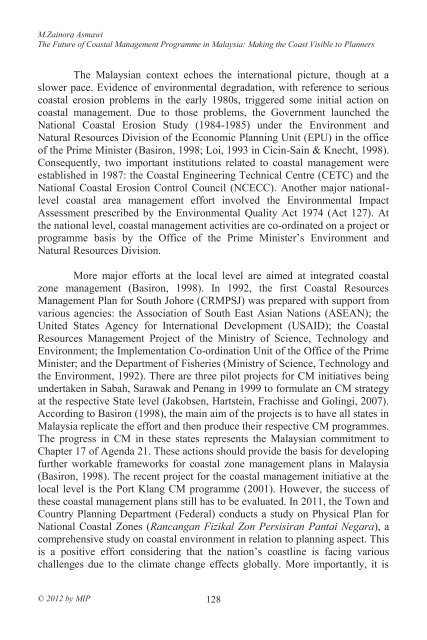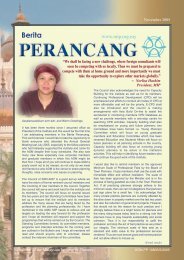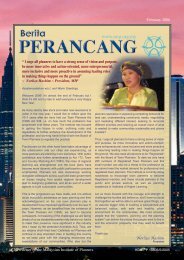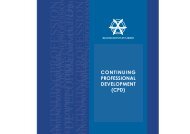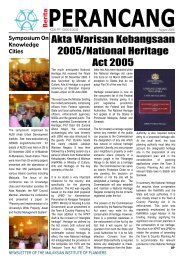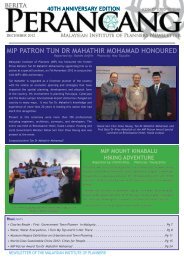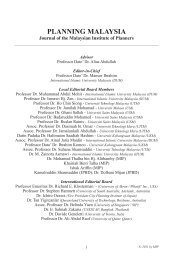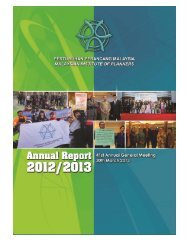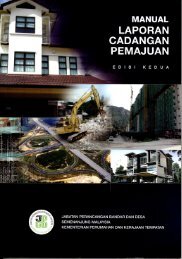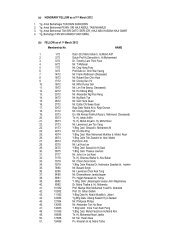Untitled - Malaysian Institute of Planners
Untitled - Malaysian Institute of Planners
Untitled - Malaysian Institute of Planners
You also want an ePaper? Increase the reach of your titles
YUMPU automatically turns print PDFs into web optimized ePapers that Google loves.
M.Zainora AsmawiThe Future <strong>of</strong> Coastal Management Programme in Malaysia: Making the Coast Visible to <strong>Planners</strong>The <strong>Malaysian</strong> context echoes the international picture, though at aslower pace. Evidence <strong>of</strong> environmental degradation, with reference to seriouscoastal erosion problems in the early 1980s, triggered some initial action oncoastal management. Due to those problems, the Government launched theNational Coastal Erosion Study (1984-1985) under the Environment andNatural Resources Division <strong>of</strong> the Economic Planning Unit (EPU) in the <strong>of</strong>fice<strong>of</strong> the Prime Minister (Basiron, 1998; Loi, 1993 in Cicin-Sain & Knecht, 1998).Consequently, two important institutions related to coastal management wereestablished in 1987: the Coastal Engineering Technical Centre (CETC) and theNational Coastal Erosion Control Council (NCECC). Another major nationallevelcoastal area management effort involved the Environmental ImpactAssessment prescribed by the Environmental Quality Act 1974 (Act 127). Atthe national level, coastal management activities are co-ordinated on a project orprogramme basis by the Office <strong>of</strong> the Prime Minister’s Environment andNatural Resources Division.More major efforts at the local level are aimed at integrated coastalzone management (Basiron, 1998). In 1992, the first Coastal ResourcesManagement Plan for South Johore (CRMPSJ) was prepared with support fromvarious agencies: the Association <strong>of</strong> South East Asian Nations (ASEAN); theUnited States Agency for International Development (USAID); the CoastalResources Management Project <strong>of</strong> the Ministry <strong>of</strong> Science, Technology andEnvironment; the Implementation Co-ordination Unit <strong>of</strong> the Office <strong>of</strong> the PrimeMinister; and the Department <strong>of</strong> Fisheries (Ministry <strong>of</strong> Science, Technology andthe Environment, 1992). There are three pilot projects for CM initiatives beingundertaken in Sabah, Sarawak and Penang in 1999 to formulate an CM strategyat the respective State level (Jakobsen, Hartstein, Frachisse and Golingi, 2007).According to Basiron (1998), the main aim <strong>of</strong> the projects is to have all states inMalaysia replicate the effort and then produce their respective CM programmes.The progress in CM in these states represents the <strong>Malaysian</strong> commitment toChapter 17 <strong>of</strong> Agenda 21. These actions should provide the basis for developingfurther workable frameworks for coastal zone management plans in Malaysia(Basiron, 1998). The recent project for the coastal management initiative at thelocal level is the Port Klang CM programme (2001). However, the success <strong>of</strong>these coastal management plans still has to be evaluated. In 2011, the Town andCountry Planning Department (Federal) conducts a study on Physical Plan forNational Coastal Zones (Rancangan Fizikal Zon Persisiran Pantai Negara), acomprehensive study on coastal environment in relation to planning aspect. Thisis a positive effort considering that the nation’s coastline is facing variouschallenges due to the climate change effects globally. More importantly, it is© 2012 by MIP 128


